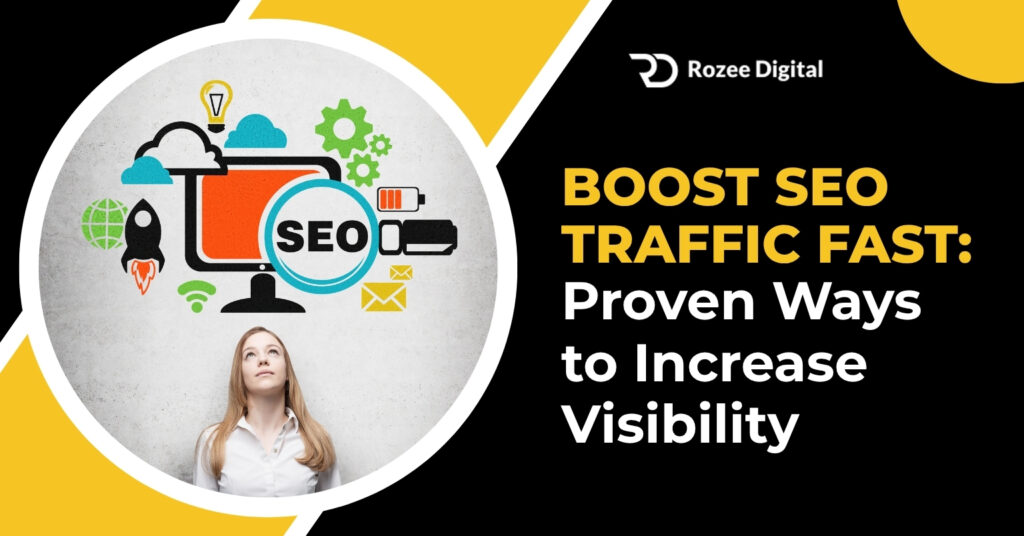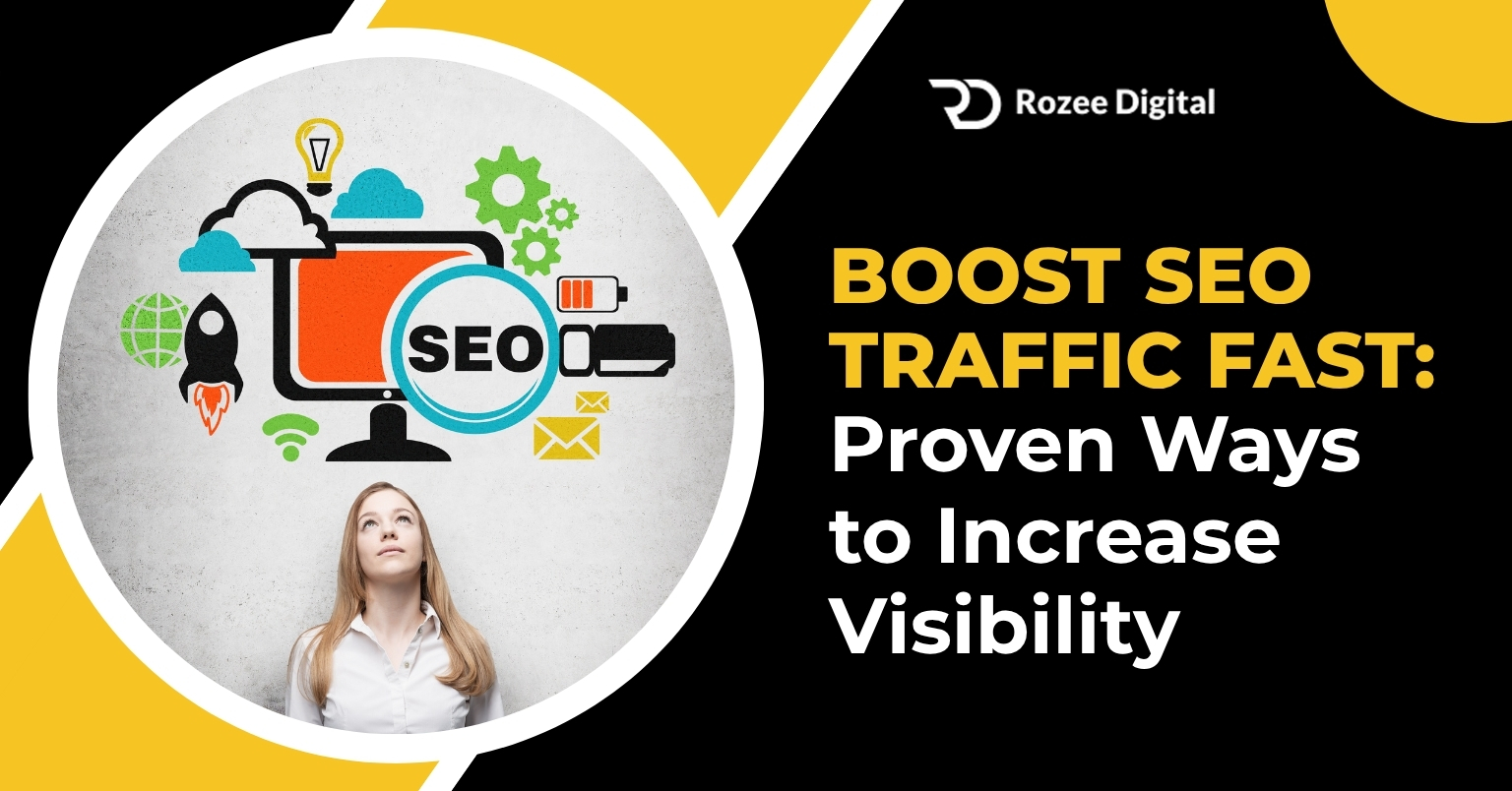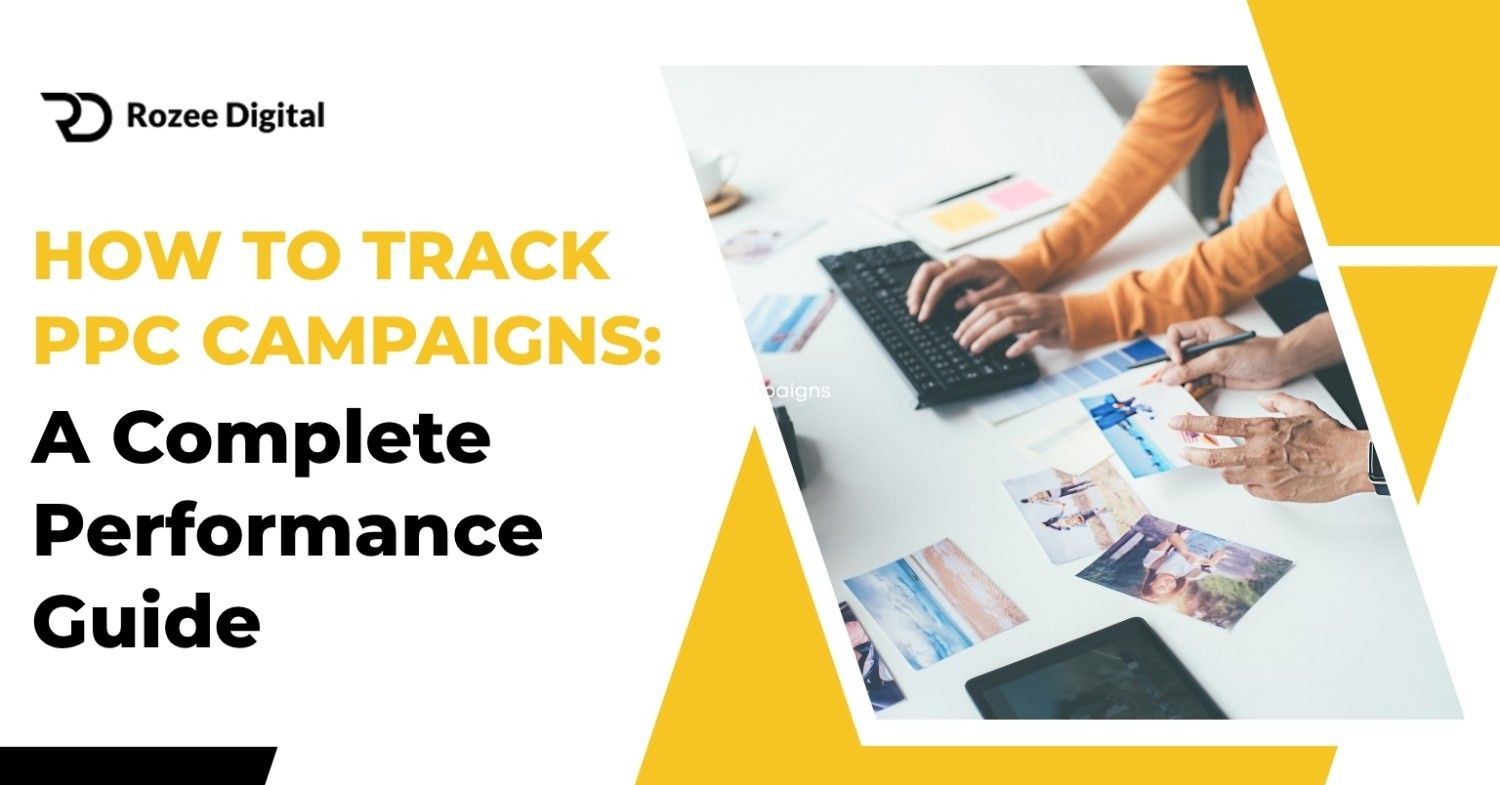Did you know that organic search drives about 58% of all website traffic according to SE Ranking (2025)? That means more than half of your visitors could find you for free if your site ranks where it matters.
But here’s the truth. Most online stores struggle to grow their SEO traffic. They don’t know what to focus on first. Some get lost in technical jargon, while others give up too soon.
The good news? You don’t need to be an SEO expert to see results. This guide walks you through simple, proven ways to boost SEO traffic fast in 2025. No confusing terms. No complicated steps. Just clear, actionable methods that actually work right now.
Why SEO Traffic Growth Strategies Matter More Than Ever
Things changed a lot in digital marketing over the past few years. Google got smarter about showing helpful content to users. Paid ads keep getting more expensive every month. But organic search traffic? It stays free forever.
Understanding SEO Impact on Website Visits for eCommerce Success
SEO isn’t just about appearing higher on Google anymore. It’s about bringing in people who actually want to buy from you. Think about it this way. When someone searches for “best running shoes,” they’re ready to shop.
Organic traffic converts better than paid ads. People trust websites that earned their spot through quality. They skip right past the ads at the top. They want real helpful content from real businesses.
This is exactly why learning how to increase seo traffic gives you a big advantage. Your competitors might spend more money on ads. But they can’t buy their way to the top of organic results. You have to earn those spots through smart work.
When you show up in organic search, people trust you more. They see you as an authority in your field. They’re more likely to buy from you. And the best part? This traffic keeps coming month after month without paying for every single click. But if you want quicker results while your SEO builds momentum, you can also explore working with a PPC ads agency to run targeted campaigns strategically.
The Real Benefits of SEO for Traffic Growth
SEO gives you results that keep growing over time. A blog post you write today can bring visitors for years. Compare that to paid ads where traffic stops the second you stop paying. Every dollar you spend on SEO builds something permanent.
Your website gets stronger with each piece of content you create. Your rankings improve gradually. Your authority grows in your industry. It all compounds like interest in a savings account.
Most online stores see real results within three to six months. That might sound like a long time. But think about where you want to be a year from now. Starting today means you’ll be way ahead of competitors who never begin.
The key is being consistent and patient. Small improvements add up to massive results. Even a ten percent monthly increase becomes three times more traffic over a year. That’s the power of compound growth working for your business.
How Google Actually Ranks Websites in 2025
Google uses hundreds of factors to decide rankings. But here’s the secret. You don’t need to worry about all of them. Focus on what matters most and you’ll see eighty percent of the results.
The Core Ranking Factors That Drive SEO Ranking and Web Traffic
Three things matter most to Google right now. Content quality, backlinks from other sites, and user experience. Master these three areas and everything else falls into place naturally.
Content quality means creating pages that actually help people. Google wants to show users the best answer to their question. If your page does that better than others, you’ll rank higher. It’s really that simple at its core.
Backlinks are like votes from other websites saying you’re trustworthy. The more quality sites that link to you, the more Google trusts you. Think of it as popularity but for websites instead of people.
User experience includes how fast your site loads and how easy it is to use. Google wants to send people to sites that work well. Slow clunky websites get pushed down in rankings. Fast smooth sites get boosted up.
The great news? You control all three of these factors completely. You don’t need special connections or secret tricks. Just consistent work improving your content, getting quality links, and making your site better for visitors.
Understanding Search Intent Unlocks Organic SEO Traffic Tips
Search intent means figuring out what people really want when they type something into Google. Someone searching “buy red sneakers” wants different results than “how to clean sneakers.” Google shows different pages for each search.
There are basically four types of searches. People looking for information and learning. People trying to find a specific website. People compare different options before buying. And people are ready to buy right now.
Your content needs to match what people actually want. A product page won’t rank for how-to questions. A blog post won’t rank when someone wants to buy. Study what’s already ranking to understand what Google thinks people want.
This is where most SEO traffic increase methods fail completely. People create content they want to rank for. Instead they should create content that answers real questions from real customers. Match what people need first, then worry about optimization second.
11 Powerful Ways to Boost Google Search Traffic Starting Today
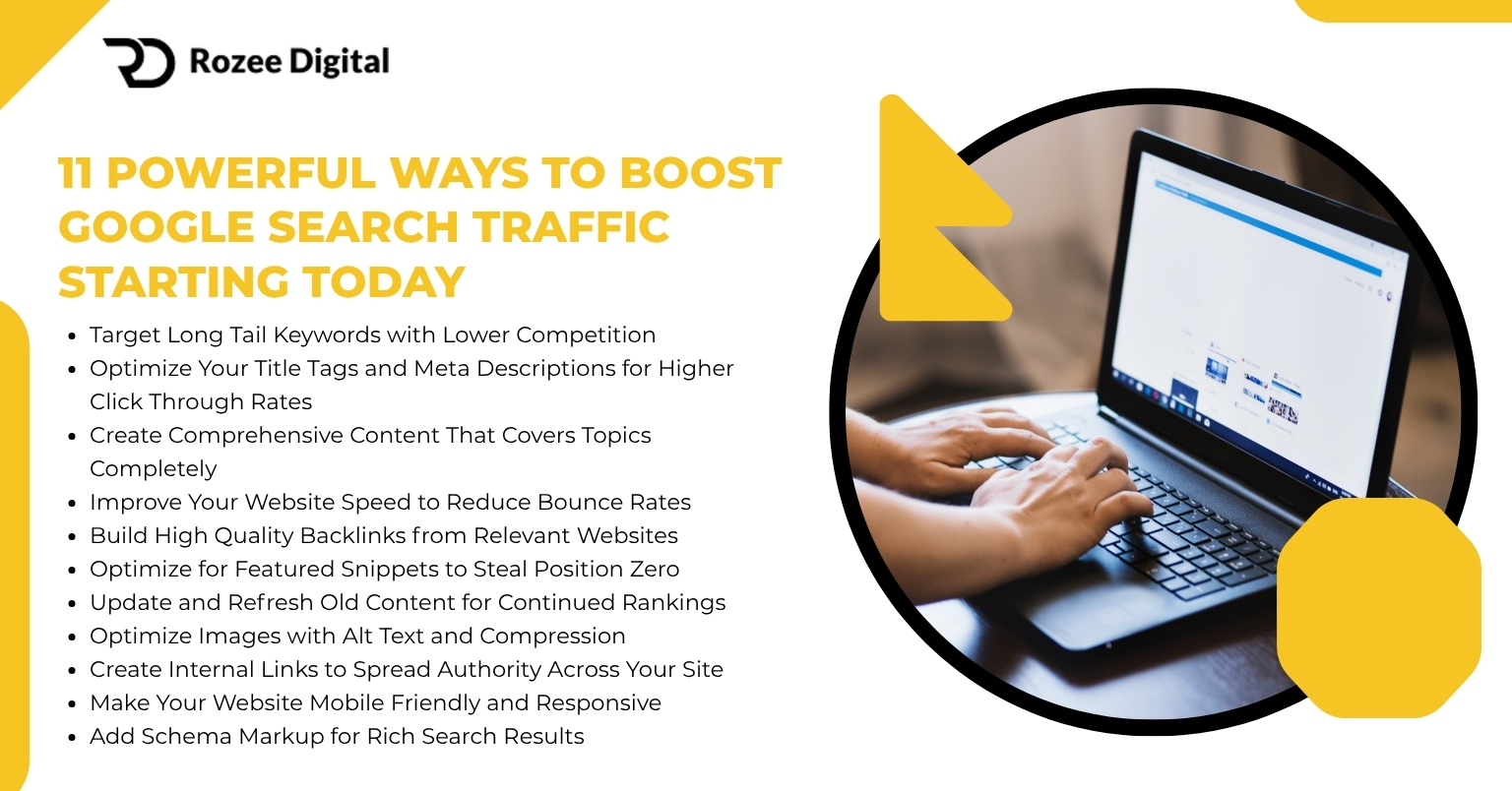
These strategies work for any size business. Start with the easiest wins and build momentum. Each improvement makes the others work even better over time.
- Target Long Tail Keywords with Lower Competition
- Optimize Your Title Tags and Meta Descriptions for Higher Click Through Rates
- Create Comprehensive Content That Covers Topics Completely
- Improve Your Website Speed to Reduce Bounce Rates
- Build High Quality Backlinks from Relevant Websites
- Optimize for Featured Snippets to Steal Position Zero
- Update and Refresh Old Content for Continued Rankings
- Optimize Images with Alt Text and Compression
- Create Internal Links to Spread Authority Across Your Site
- Make Your Website Mobile Friendly and Responsive
- Add Schema Markup for Rich Search Results
1. Target Long Tail Keywords with Lower Competition
Long-tail keywords are longer and more specific search phrases. Instead of just “shoes,” try “comfortable running shoes for flat feet women.” These specific phrases convert way better into actual sales.
Most keywords get searched less than ten times per month. But there are millions of these small keywords combined. Most businesses ignore them chasing the big popular keywords. That’s your opportunity right there.
Long-tail keywords are much easier to rank for quickly. A new store can’t compete with Nike for “running shoes.” But “eco-friendly trail running shoes under 100 dollars” has way less competition. You can actually win there.
Use free tools to find these keywords. Google’s “People Also Ask” section shows related questions. Type your main keyword into Google and look at the suggestions. Those are real things people actually search for.
Create pages targeting these specific phrases. One good page can rank for dozens of long-tail variations at once. This is how you increase website traffic SEO without fighting impossible battles against giant competitors.
2. Optimize Your Title Tags and Meta Descriptions for Higher Click Through Rates
Your title tag is the blue clickable headline people see in search results. Your meta description is the gray text underneath it. Together they decide if people click your result or skip to someone else’s.
Titles with numbers perform better than titles without them. “7 Ways to…” gets more clicks than just “Ways to…” Questions in titles also boost clicks. People want answers to their specific questions.
Keep titles under sixty characters so they don’t get cut off. Include your main keyword near the beginning. Add power words like “proven,” “fast,” “easy,” or “ultimate” to make it sound more appealing.
Meta descriptions should be around one hundred fifty characters. Include your keyword naturally and tell people what benefit they’ll get. Think of it like writing ad copy to convince people to click.
When more people click your result, Google notices. They see that users prefer your page over competitors. This sends positive signals that can improve your rankings even more. It’s a virtuous cycle of improvement.
3. Create Comprehensive Content That Covers Topics Completely
Google loves content that fully answers everything someone wants to know. One big complete guide beats five short articles on the same topic. Depth and thoroughness matter more than just writing a lot of words.
Look at what’s currently ranking for your target keyword. Create something significantly better with more detail, clearer examples, and better organization. This is called the skyscraper technique because you’re building something taller than what exists.
Cover all the related questions someone might have about your topic. Don’t just answer one narrow question. Think about what else they’d want to know next. Include all of that in one comprehensive resource.
This is one of the most effective SEO optimization for traffic strategies available. Complete content naturally earns links from other sites. It keeps visitors reading longer. And it ranks for hundreds of related keywords all at once.
Your goal should be creating the single best resource on the internet for your topic. When someone reads it, they shouldn’t need to visit another site. They got everything they needed from you. That’s when rankings and traffic really take off.
4. Improve Your Website Speed to Reduce Bounce Rates
Page speed matters a lot for both rankings and sales. People leave slow websites immediately. Every extra second of loading time costs you visitors and money. Google knows this and ranks faster sites higher.
Test your speed using free tools like Google PageSpeed Insights. It shows exactly what’s slowing you down. Usually it’s images that are too large or too many plugins and apps running in the background.
Compress all images before uploading them. Use free tools like TinyPNG. This makes files smaller without making images look worse. It’s the easiest way to speed up your site immediately.
Remove apps and plugins you don’t actually need. Every extra piece of code slows things down. Go through your site and delete anything that’s not essential. You’d be surprised how much faster things get.
Speed improvements help everything else work better. People stay on your site longer. They view more pages. They’re more likely to buy. And Google ranks you higher. It’s one change that creates multiple benefits at once.
5. Build High Quality Backlinks from Relevant Websites
Backlinks are still super important for rankings. These are links from other websites pointing to yours. They tell Google that other people find your content valuable enough to reference.
Quality beats quantity completely now. One link from a major industry site is worth more than a hundred links from random directories. Google looks at the authority and relevance of sites linking to you.
Guest posting works really well for getting quality links. You write helpful content for other blogs in your industry. They publish it with a link back to your site. Everyone wins. They get free content and you get a valuable link.
Create content that naturally earns links without asking. Original research, comprehensive guides, and helpful tools attract links automatically. Other sites want to reference valuable resources for their own readers.
Reach out to websites that link to your competitors. Explain why your content is even better and suggest they link to you instead. This works surprisingly well when done politely and professionally.
6. Optimize for Featured Snippets to Steal Position Zero
Featured snippets are those boxed answers that appear above regular search results. They’re called “position zero” because they come before the number one spot. Getting featured here brings tons of traffic.
Snippets come in different formats. Paragraph answers, numbered lists, bullet lists, and tables. Look at what format Google shows for your keywords. Then structure your content to match that exact format.
For paragraph snippets, give a clear forty to sixty word answer right away. Use the question as your heading. Then provide the direct answer immediately below. Expand with more details after that.
For list snippets, use numbered or bulleted lists with clear formatting. Make each point concise and easy to scan. For tables, organize data in clean HTML tables. Google pulls these directly into featured snippets.
Answer common questions directly and simply. “What,” “how,” “why,” and “best” questions often trigger snippets. Structure your content to answer these question types clearly and you’ll increase your chances dramatically.
7. Update and Refresh Old Content for Continued Rankings
Updating old posts often works better than creating new content from scratch. Google likes fresh current information. A simple update can bring back rankings and traffic to existing pages.
Start with your top twenty pages by traffic. These already have authority and links. Updating them builds on those existing advantages. Check Google Analytics for pages that used to rank well but dropped recently.
Add new sections covering recent developments. Update all numbers and facts to the current year. Replace old screenshots with current ones. Expand sections that feel too short or incomplete.
After updating, change the publication date. This tells Google the content is fresh and current. Many updated posts jump back to page one within just a few weeks.
This strategy works because you’re improving something that already proved valuable. You’re not starting from zero with a brand new page. You’re making something good even better with less effort.
8. Optimize Images with Alt Text and Compression
Images help SEO in several ways. They make content more engaging. They reduce bounce rates. And they can rank in Google Image Search bringing additional traffic.
Alt text describes what’s in an image. It helps Google understand your images since they can’t actually see them. Include relevant keywords naturally when describing what the image shows.
Name your image files descriptively before uploading. Instead of “IMG_1234.jpg,” use “red-running-shoes-women.jpg” with keywords separated by dashes. This helps images rank in Google Image Search.
Compress images to reduce file sizes. Large images are the biggest cause of slow page speeds. Free compression tools reduce file sizes by fifty to eighty percent without visible quality loss.
Google Image Search gets billions of searches. That’s a huge traffic source most people completely ignore. Optimizing images properly lets you tap into this additional source of free targeted visitors.
9. Create Internal Links to Spread Authority Across Your Site
Internal links connect different pages on your website together. They help Google discover content and understand how your site is organized. Strategic internal linking boosts rankings across your entire site.
Link from your strongest pages to pages you want to rank higher. Your homepage usually has the most authority. Use that power to boost other important pages by linking to them.
Use descriptive anchor text when linking. Instead of “click here,” use actual keywords like “organic cotton t-shirts” as the clickable text. This tells Google what the linked page is about.
Add three to five internal links in every blog post or page. Link to related products, relevant blog posts, or category pages. This keeps visitors exploring your site longer while spreading authority around.
Most websites barely use internal links at all. This is easy low-hanging fruit for immediate improvement. Just adding proper internal links to existing content can boost rankings noticeably within weeks.
10. Make Your Website Mobile Friendly and Responsive
Most people browse on their phones now. Google ranks sites based on the mobile version primarily. If your site doesn’t work well on mobile, you’re losing rankings and customers.
Test your site on actual phones and tablets. Check that buttons are big enough to tap easily. Make sure text is readable without zooming in. Ensure forms work smoothly on touchscreens.
Responsive design automatically adjusts your layout for different screen sizes. This is standard practice now. If your site isn’t responsive yet, fixing this should be your top priority immediately.
Mobile users have even less patience than desktop users. They abandon slow sites instantly. Make sure your mobile site loads super fast. Remove anything that slows it down unnecessarily.
Mobile optimization isn’t optional anymore. It’s the basic expectation. Sites that ignore mobile experience lose half their potential customers to competitors with better mobile sites.
11. Add Schema Markup for Rich Search Results
Schema markup is special code that helps Google understand your content better. It enables rich results like star ratings, prices, and availability showing directly in search results.
Rich results make your listing stand out visually. Pages with star ratings get clicked way more than pages without them. You look more prominent and trustworthy compared to regular blue links.
Common schema types for online stores include Product, Review, FAQ, and Breadcrumb markup. Use Google’s free Structured Data Markup Helper to generate the code without needing technical skills.
Product schema shows price and availability in results. Review schema displays star ratings. FAQ schema expands answers directly in results. Each type makes your listing more eye-catching and clickable.
After adding schema, test it with Google’s Rich Results Test tool. This shows if the markup is working correctly. Then submit your sitemap to Google Search Console so they can find and use it.
Tracking SEO Traffic Growth with the Right Metrics
You can’t improve what you don’t measure. Most businesses track the wrong things or don’t track anything at all. Focus on metrics that actually predict business growth.
Essential Metrics for Measuring Organic Search Traffic Boost
Organic traffic is the obvious starting point. Google Analytics shows how many visitors come from organic search. Track this monthly and look for consistent upward trends.
But total traffic doesn’t tell the whole story. Track traffic to your most important pages separately. A thousand visits to blog posts matters less than a hundred visits to product pages. Segment traffic by page type.
Conversion rate shows whether traffic is qualified or not. If organic traffic increases but sales stay flat, you’re attracting the wrong visitors. You need to match keywords to buyer intent better.
Time on page and pages per visit indicate engagement quality. Visitors staying longer and viewing multiple pages are more likely to buy. These metrics help you evaluate if content is actually helpful.
Keyword rankings for your target terms show progress even before traffic increases. Track your top twenty target keywords monthly. Moving from position fifteen to eight means traffic will jump very soon.
Using Google Search Console to Identify Quick Wins
Google Search Console is free and shows exactly how Google sees your site. It reveals which queries you’re ranking for, your average position, and click-through rates.
Look at impressions versus clicks. High impressions with low clicks means you’re ranking but not getting clicked. Improve your titles and descriptions for those queries to capture more clicks.
Find keywords ranking in positions four to ten. These are quick-win opportunities. Small improvements can push them to page one. Add more content, improve internal linking, and update freshness.
The Coverage report shows indexing errors preventing pages from ranking. Fix crawl errors and broken links immediately. These technical issues cost you rankings for no good reason.
The Core Web Vitals report shows if your site meets Google’s speed standards. Pages failing these thresholds suffer ranking penalties. Prioritize fixing your most visited pages first.
Common SEO Mistakes Killing Your Traffic Growth
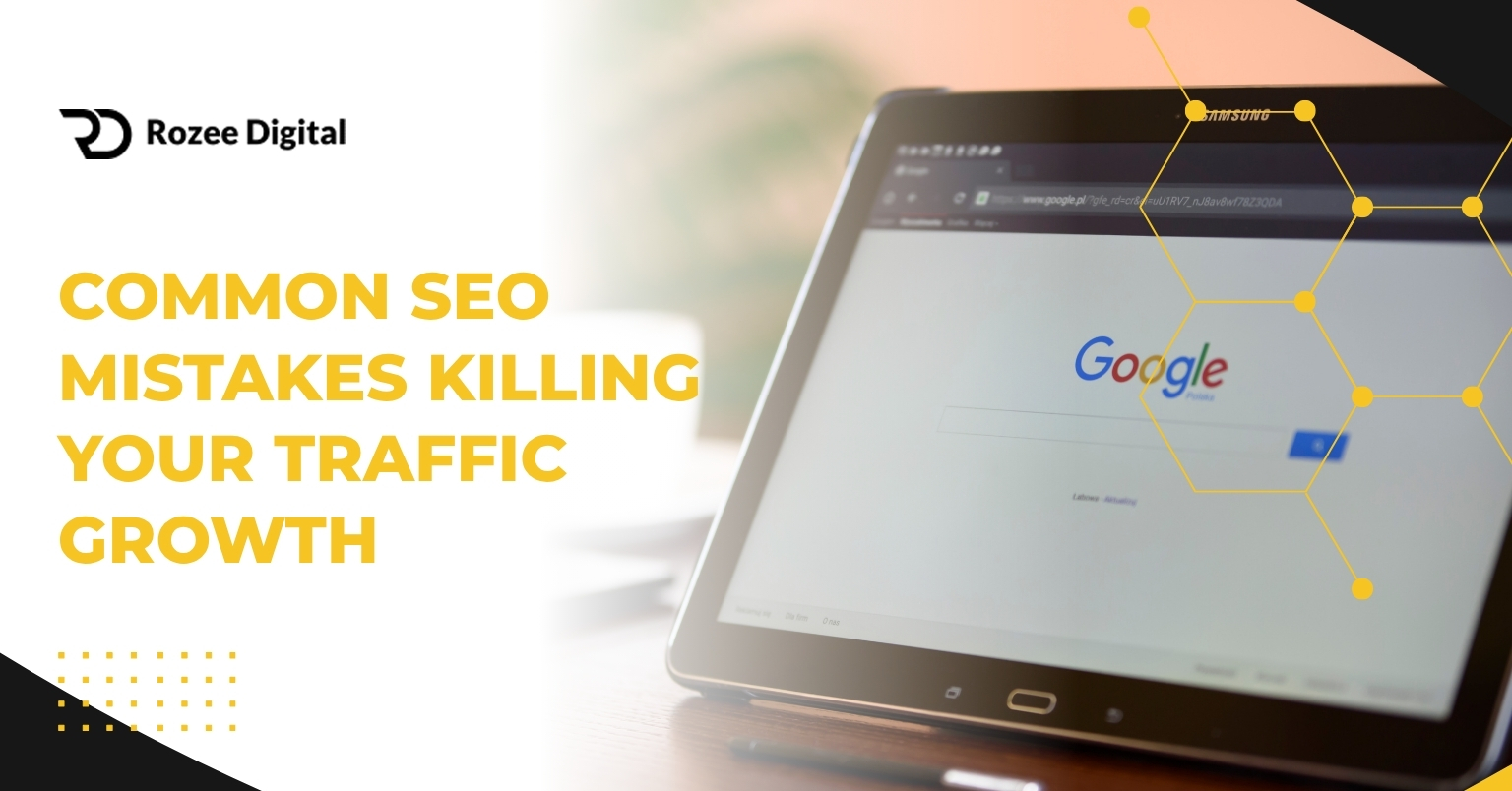
Even experienced people make these mistakes. Avoiding them puts you ahead of most competitors. Small fixes often deliver big results compared to the effort required.
Keyword Stuffing and Over Optimization Penalties
Keyword stuffing means forcing keywords into content unnaturally and repeatedly. Google detects this easily and penalizes sites for it. Always write for humans first, search engines second.
Use your main keyword once per hundred words maximum. That’s roughly one percent density. Use variations and related terms naturally throughout content. Focus on readability over keyword frequency.
The solution is simple. Write naturally helpful content. Include keywords where they fit smoothly. Don’t force them where they sound awkward or weird. Google understands topics without needing exact keyword repetition.
Over-optimization looks manipulative to Google. They expect natural patterns. When everything looks too perfect and deliberate, it raises red flags. Natural variation is actually better than forced perfection.
Ignoring Technical SEO Issues That Block Rankings
Technical SEO is the foundation everything builds on. Technical problems prevent even great content from ranking. Many businesses focus only on content while ignoring technical issues.
Check that Google can actually access your pages. Your robots.txt file shouldn’t block important pages. Your XML sitemap should be submitted to Google Search Console so they know what to crawl.
Duplicate content confuses Google about which version to rank. Canonical tags tell them which version is the main one. Use these consistently across your entire site.
HTTPS security is required now. Sites still using HTTP get ranking penalties. SSL certificates are cheap and essential for credibility anyway. There’s no reason not to have this.
Site structure affects how authority flows through your website. Important pages should be close to your homepage. Keep valuable pages within three clicks of the homepage for best results.
Creating Content Without Understanding Search Intent
This is the biggest reason content fails to rank. You create what you think people want instead of what they actually search for. Google shows content that matches user intent precisely.
Study the current top ten results for your target keyword. See what type of content is ranking. If it’s all comparison articles, don’t try to rank with a product page. Match the existing format.
Content format matters as much as the topic itself. Some searches want lists, others want guides, some want videos. Match your format to what’s already working in the top results.
Search intent also determines how deep content should be. Quick answer questions need short responses. Complex topics need comprehensive guides. Mismatching depth to intent hurts your chances regardless of quality.
How Long Does It Take to See Results from SEO Efforts
SEO is a long-term strategy that requires patience. Most businesses quit too early before results compound. Understanding realistic timelines prevents giving up prematurely.
Typical Timeline for Organic SEO Traffic Tips to Work
New websites typically take six to twelve months to see good organic traffic. You’re building authority from nothing. Google needs time to trust your site and crawl content regularly.
Established websites see results faster, usually within three to six months. You already have some authority and backlinks. New content benefits from that existing trust right away.
Small wins appear much sooner though. You’ll see ranking improvements within weeks. Easy keywords often rank within thirty to sixty days. These early wins build momentum and motivation.
Quick fixes like improving page speed or updating titles show results within days. Google recrawls most sites weekly or more often. Changes to already-indexed pages get noticed pretty quickly.
Factors That Accelerate or Delay SEO Success
Your domain age and authority dramatically affect the timeline. Brand new domains face a waiting period where rankings are limited. Older domains with backlinks rank new content much faster.
Competition level matters enormously. Low-competition keywords rank within weeks. Highly competitive terms take months or years. Choose battles you can actually win based on your current authority.
Content quality determines whether pages rank and stay ranked. Thin basic content might rank temporarily but drops quickly. Thorough valuable content ranks and maintains position long-term.
Technical health determines how efficiently Google can work with your site. Sites with major technical problems see delayed results no matter how good the content is. Fix foundation issues first.
SEO Success Stories from Real eCommerce Businesses
Real examples prove these strategies work when applied consistently. These businesses didn’t have special advantages. They just followed best practices and stayed patient.
How One Store Increased Website Traffic SEO by 312% in 8 Months
A small outdoor gear store struggled with just two thousand monthly visitors. They focused on long-tail keywords and helpful content. Eight months later they had over eight thousand monthly visitors.
Their strategy centered on creating detailed buying guides. Instead of targeting generic terms, they got specific. “Best camping gear for families with toddlers” and similar detailed topics.
They created forty-seven comprehensive guides over six months. Each targeted five to ten related keywords. They updated product pages with better descriptions. They added schema markup for rich results.
One guide ranking number one started attracting backlinks naturally. Other outdoor blogs linked to it as a helpful resource. This boosted their entire domain authority significantly.
Traffic grew month over month consistently. Month three saw fifteen percent growth. Month six hit forty percent growth. By month eight they crossed three hundred percent total growth from the starting point.
The Software Company That Dominated Through Content
A project management software company faced tough competition from bigger players. Paid ads were too expensive to be profitable. They switched entirely to SEO and content marketing.
They identified two hundred long-tail keywords their customers searched. Instead of targeting broad terms, they focused on specific problems. “How to manage remote team communication” and similar pain points.
Over twelve months they published one hundred eighty helpful articles and guides. Each piece solved a specific problem their software addressed. They optimized aggressively for featured snippets.
Results started slow. Month three brought eight hundred organic visitors. Month six reached three thousand visitors. Month nine hit twelve thousand. By month twelve they maintained over twenty-eight thousand monthly organic visitors.
Their content earned backlinks from industry sites naturally. As authority grew, new content ranked faster. They now publish twice weekly and consistently rank in top positions for their target keywords.
Building a Sustainable SEO Strategy for Long Term Growth
One-time optimization isn’t enough anymore. SEO requires ongoing effort and adaptation. But consistent small actions compound into huge results over time.
Creating an SEO Content Calendar That Drives Results
Consistency beats perfection every single time. Publishing one quality post weekly outperforms random bursts of five posts then silence. Google rewards sites that update regularly.
Start by listing your top fifty target keywords. Sort them by search volume and competition level. Create one comprehensive piece targeting three to five related keywords per week minimum.
Mix different content types strategically. Alternate between product pages, informational posts, comparison guides, and tutorials. This captures different stages of the buyer journey.
Plan seasonal content several months ahead. If you sell winter gear, create holiday guides in September. Google needs time to discover, index, and rank new content before peak season.
Track what’s working monthly. Double down on topics driving traffic and sales. Stop or change topics that consistently underperform. Let actual data guide your content decisions.
Measuring ROI and Justifying SEO Investment
SEO generates real business results when tracked properly. Connect organic traffic to actual revenue, not just vanity metrics. This justifies continued investment and budget.
Calculate what each organic customer costs you. Divide total SEO spending by new customers from organic search. Compare this to what paid ads cost per customer. SEO usually wins big.
Track lifetime value of organic customers versus other channels. Organic customers often spend more over time because they found you through helpful content voluntarily.
Monitor rankings for keywords that drive sales. A single number one ranking for a buying-intent keyword can generate thousands in monthly revenue. Track these commercial keywords specifically.
Set quarterly goals for traffic growth, ranking improvements, and revenue from organic. Review progress monthly. Adjust based on what’s actually working. SEO compounds when you stay consistent and data-driven.
Key Takeaways for Sustainable Traffic Growth
Increasing website traffic through SEO doesn’t require huge budgets or expert knowledge. Start with these core principles and build from there. Small consistent improvements create substantial results.
Focus on genuinely helpful content that fully answers user questions. One exceptional complete guide beats ten shallow posts on the same topic. Depth and quality always win in the long run.
Technical SEO provides the foundation for everything else. Fix speed issues, ensure mobile works perfectly, and implement schema markup. These technical elements determine whether great content can actually rank.
Build quality backlinks systematically through guest posting and creating link-worthy content. One quality link from a relevant site beats hundreds of spam links. Focus on relevance and authority.
Track metrics that matter for your business. Organic traffic is important but conversion rate and revenue are the ultimate measures. Optimize for business outcomes, not just rankings.
Stay patient and consistent. SEO rewards long-term thinking and sustained effort. Most businesses quit right before results compound. The brands dominating organic search simply outlasted competitors who gave up too early.
Ready to level up your growth using proven SEO strategies? Rozee Digital specializes in helping eCommerce brands increase website traffic SEO through smart optimization methods. Our approach combines technical fixes, content strategy, and link building for sustainable organic growth.
FAQs
Q.1: How long does it take to increase website traffic SEO?
Most websites see results within three to six months of consistent work. Quick wins appear in weeks, but sustainable growth requires patience and ongoing effort.
Q.2: What is the fastest way to boost Google search traffic?
Focus on low-competition long-tail keywords first, fix technical issues like page speed, and optimize title tags for higher click-through rates.
Q.3: How can SEO increase web traffic without paid advertising?
SEO attracts visitors actively searching for your products. Unlike paid ads, organic rankings drive free targeted traffic that compounds over time.
Q.4: What are the most important SEO ranking factors in 2025?
Content quality, backlinks from relevant sites, and user experience including page speed and mobile-friendliness matter most to Google.
Q.5: How much should eCommerce stores invest in SEO?
Most businesses allocate fifteen to thirty percent of their marketing budget to SEO. Expect to invest one thousand to five thousand monthly for meaningful results.
